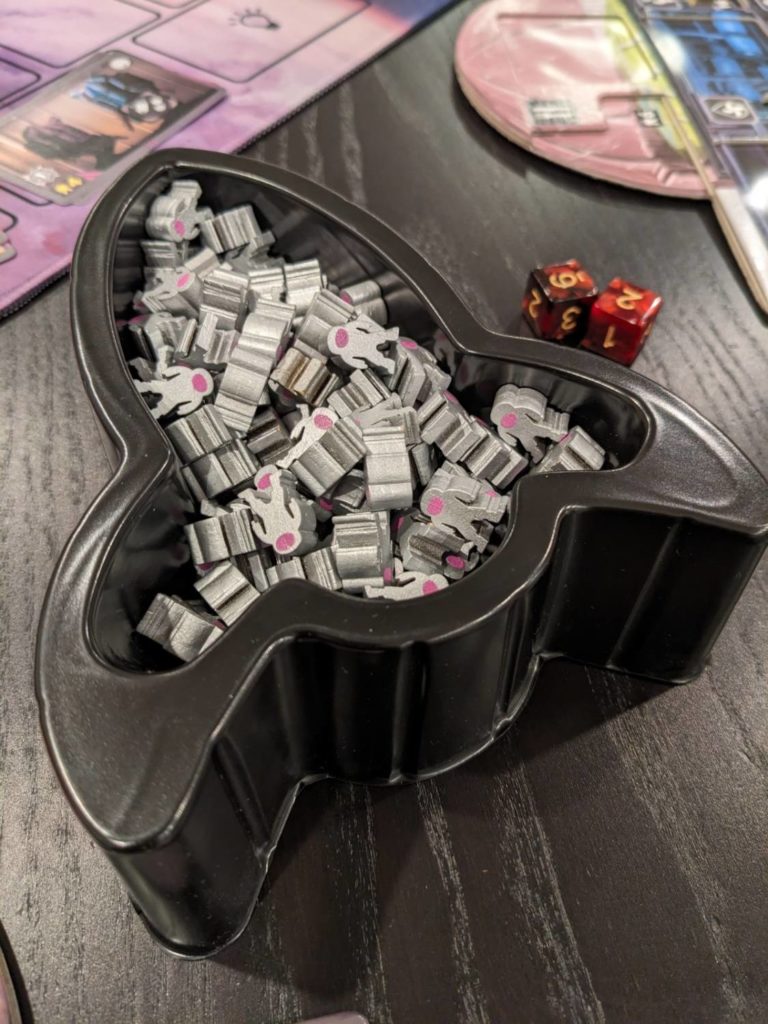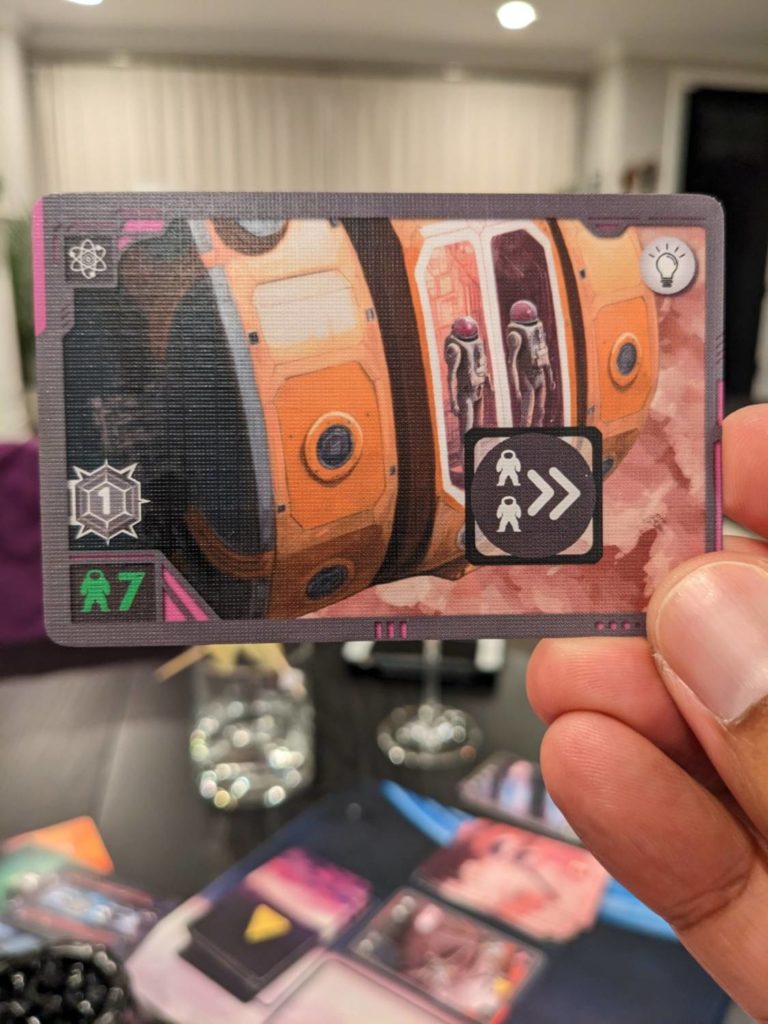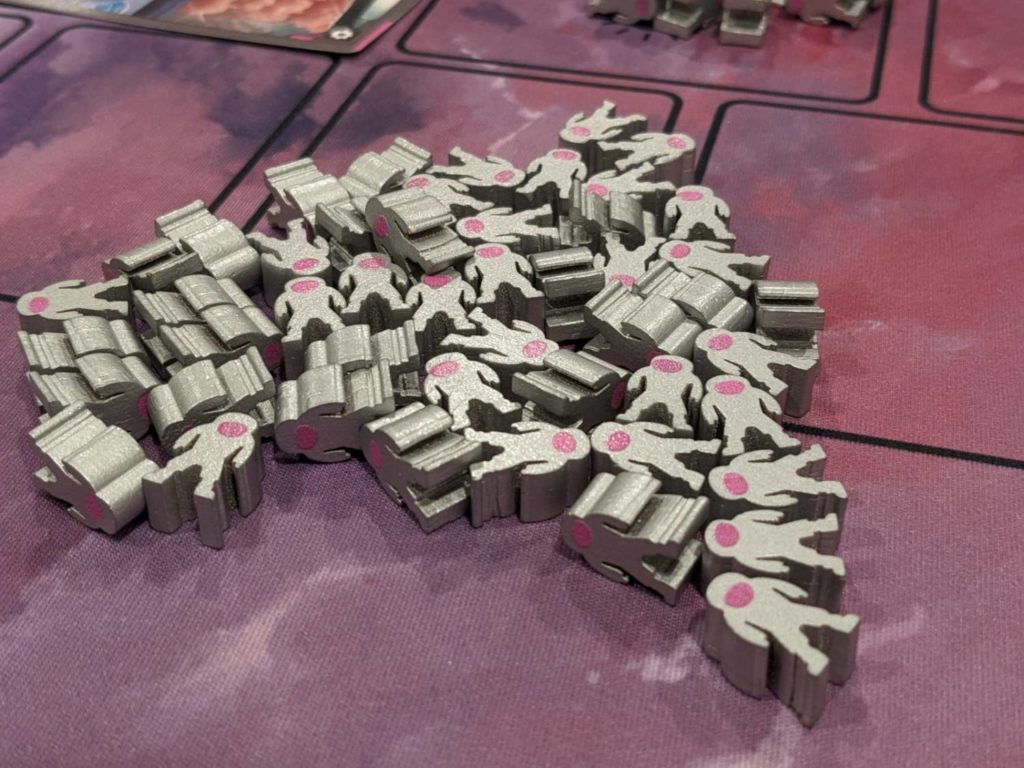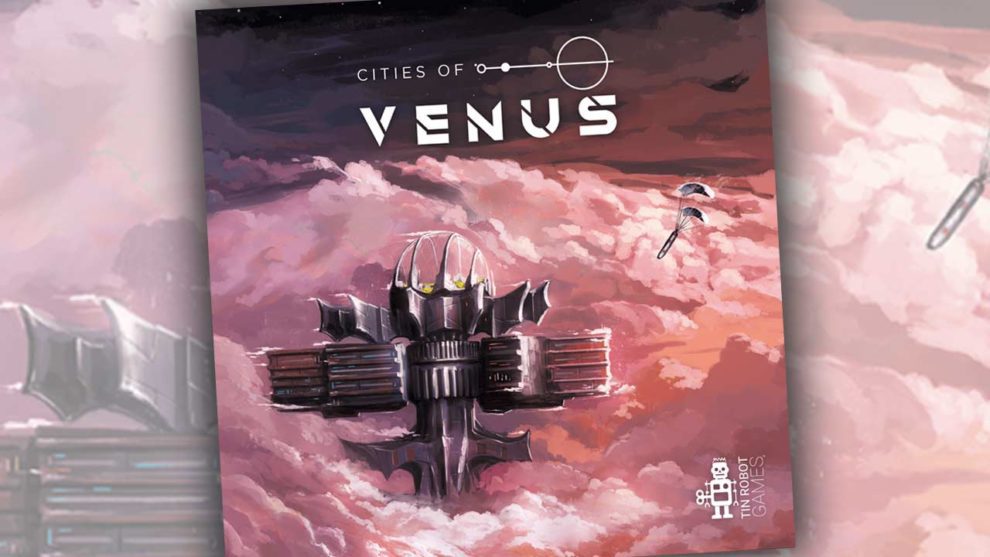Disclosure: Meeple Mountain received a free copy of this product in exchange for an honest, unbiased review. This review is not intended to be an endorsement.
I don’t review prototypes as much as I used to. Many of the elements for games that are about to hit crowdfunding platforms aren’t quite done yet. Components are certainly not final; that’s a given. But also, the rules for many of the games that have yet to reach retail are also not done, and can sometimes change drastically.
Our team had the chance to preview the game Cities of Venus (expected release: 2024, Tin Robot Games), and I really liked the theme of the game—along with the shorter play time—so I bit on giving this one a shot. The components, even in their unfinished state, have real promise as players take on the roles of leaders of floating cities on Venus in the year 2222.
Let’s get right to the point: Cities of Venus isn’t very good. In this review, I want to explore not only my thoughts on the game, but my thoughts on where games like this appear to be headed.

“I’m Not Quite Sure How to Categorize This”
It is a running joke amongst my peers in the tabletop review space that we are guilty of trying to categorize games to simplify the mechanisms for gaming veterans. We toss around terms like “tableau builder”, “worker placement”, “Euro”, and “4X” expecting some of our readers to know what those mean, but they really do mean something to an experienced player.
Cities of Venus somehow escaped my attempts to categorize it when I showed it to two separate groups of players. Even now, while writing this review, I went to BGG to see how the game’s mechanisms are described, and the only one listed is “worker placement”, the idea that you are taking a pawn from your supply to place on either a shared board or an individual player mat to select an action.
Cities of Venus is not a worker placement game. If anything, the workers are resources, which will be spent or often killed off in service of the card selection mechanism that ends each round.
Two to four players take on the roles of leaders of individual floating city-states on Venus in a future 200 years from now. Time is running out for the citizens of these cities; Earth has reliably been sending “Cloud-drops” for years, providing valuable supplies, but apparently something bad has happened on Earth and these drops are about to end.
Over the course of a number of turns, players complete six steps each round. The first five are done simultaneously and without any interactions between players: refresh a market of cards, resolve events that usually kill off some of the citizens from various departments in each city, grow population and send some of them off to research innovations, and take minor actions to gather minerals (currency) or buy new citizens by taking an immigration action. My favorite of these steps is the Lower Shields step; in this step, you simply lose a citizen from your Shields department every turn, and there’s no way around this. Someone just gets murdered from your board every round!

(Can you imagine working in a department where the team would slowly get smaller every few months, and when you ask your supervisor about the missing team members, they actually told you the truth? “Justin, I meant to tell you during onboarding: working in the Shields department is a one-way trip. My bad.”)
Five of the six steps in each round take mere seconds to complete. The sixth step is also quick, but must be done in turn order: players select one of the available canister cards (those Cloud-drops that I mentioned earlier) by paying a cost and either adding it to their player board or boosting population in a department before burning the card. Some cards are worth points, some are not, and there doesn’t seem to be a consistent formula for what makes some cards more valuable than others.
Worse, the cards are dealt randomly to start a round, and the first player in a round simply gets the chance at the best card. Even though Cities of Venus is meant to serve as a gateway gaming experience, even newer tabletop players will not appreciate the fact that the best cards seem to show up at inopportune times. I thought it was hilarious how often the first player had the only good choice of high-point cards in a round.
And that’s the game. Rounds continue in this fashion until a card representing Earth—buried somewhere in the bottom-third of the canister card deck during setup—shows up, signifying the final round of play. Points come from a mix of the points on the canister cards, leftover “V-nauts” (citizens), leftover minerals, innovations (permanent upgrades that are researched by spending eight of your V-nauts from an innovation research mini-board), plus a small award for the player that had the most leftover V-nauts and total minerals.

Where’s the Fun?
Cities of Venus really struggled in the area that should have been a home run: it’s never very interesting, despite being such an easy game to teach and speed through.
There are no wow moments; on its own, that’s not a killer. Plenty of games are steadily interesting without the wow. But Cities of Venus doesn’t have much in the way of even semi-interesting moments.
Dealing out the cards to start a round? That’s administration, along with murdering off one of the guys from Shields. Population growth is a formula, so there’s nothing to speak about there. Events only take place if the market cards show an event symbol; even then, all of the event cards are flavorless, describing the loss of V-nauts or occasional growth.
Cities of Venus had a minor chance to heat up during step five, City Actions, but the game gets in its own way here.
You have three choices during City Actions, all of which can be done multiple times and in any order. You could mine for minerals, which is so dangerous that the act kills off one V-naut from the mining section for each roll of a six-sided die. The roll produces 1-6 minerals, which can be spent for immigration (another City Action) at a rate of four minerals to produce one V-naut. But what if you roll poorly? Oh well, you’re not very good at board games, so you just don’t produce much cash and that V-naut’s life was wasted.
With the acquisition of certain canister cards, you can mitigate poor rolls by getting a single re-roll, or a chance to roll two dice instead of one. That’s great. But what if you are unlucky enough to not go first or second in a round where there are only one or two cards that have these mining upgrades available? Yep, you guessed it—you aren’t very good at board games.
I was surprised how often the sixth step of each round was also not very interesting; this was especially true late in each game, because by the end of play you will likely have full departments of V-nauts and can’t add more staff. You might also have cards you are happy with that also score a decent number of points, so you’ll likely pass and take a single V-naut to add to your city board instead.
Early in the game, it makes a ton of sense to just boost your population in the departments that allow for larger and larger population growth on future turns. This led to a fairly boring finish to each of my plays of Cities of Venus, as players just killed off their miners to try and gamble on scoring more points with their leftover minerals.

It’s a Pass
One of the players in my review crew had this to say about Cities of Venus after his first play:
“That’s the worst game I have ever played.”
I felt that this was harsh, but I wasn’t far behind him. I’ve played about 300 unique games over the last two years, and Cities of Venus ranks near the bottom. But that raised other questions for me, mainly around my thoughts about the deluge of games that keep coming to crowdfunding looking for a handout:
Why does this game exist?
What does this game add to the hobby? What unique theme, mechanisms, or combination of previously attempted elements made the designers push forward with publication?
Did this game really go through hundreds, ideally thousands, of test plays to determine if it was balanced from a rules perspective? Was the game still fun for the testers after hundreds of plays? How much development did the game receive from industry veterans to shape the final ruleset? Will the rules change again based on the feedback from people like myself?
There’s a lot to answer here, but it’s clear that Cities of Venus needs a lot more time in the oven, and likely an overhaul to make the lack of interaction more interesting. You are never spending time fiddling with your player board to optimize your position. There is definitely no worker placement in this game, but there’s also nothing that makes this feel like an efficiency engine builder. The best thing I can say here is that I guess it is fun to roll dice to see how many minerals you’ll end up with, but it won’t feel good when you win a game because of your proficiency with rolling dice. (Yes, this happened to me.)
To the credit of the game’s designers, James Staley and Adam Staley, it delivers on the Tin Robot Games promise: this is a game that can definitely play fast. Even my learning game of Cities of Venus took about an hour with three players; with two players, this is a 30-minute game in the hands of competent adults. It is beyond easy to teach—the finished game will need a player aid to help sort out the symbology on both the canister and event cards—and is very quick to set up and tear down.
I can’t comment for sure yet on the components, because the player boards used here will certainly look different and hopefully be a bit more sturdy during their fulfillment. As is, the boards are badly warped (the final boards will be “quad-layer”; I can’t figure out why player board thickness has become such a tabletop selling point!!) and the V-naut meeples don’t have much heft to them. There’s no first player marker, so I just used one of my own; there’s also no way to track scores, so a scorepad or score tracker will also need to be included in the final game. The game should give players an equal number of rounds to serve as the first player because the card draw during the final action of each turn is a big deal in Cities of Venus.
The rulebook goes into some of the science behind what would make life so tough on Venus, but literally none of that theme comes through in the game. That’s a shame, because I think it would be interesting to explore more about what makes Venus, well, Venus. As is, save for killing off a guy from the Shields department (because the air on Venus is so acidic?), there’s really nothing that drives a narrative of running a floating city-state, politics of running your mini-nation, science, or, well, anything.
As usual, I wish the best to the design team and that backers find more satisfaction in the gaming experience than I did. Cities of Venus will need to undergo some major changes to shine with a broader audience.











Dang guess I won’t even bother opening this one when it arrives 🤣 too bad the art and everything drew me in!